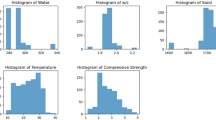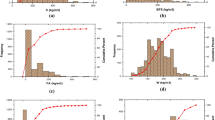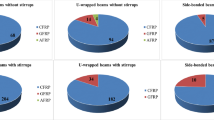Abstract
This study aims to develop a hybrid machine learning model, so-called Genetic algorithm–Artificial neural network (GA-ANN), for efficiently predicting the axial load-carrying capacity (ALC) of concrete columns reinforced with fiber reinforced polymer (FRP) bars. For that, a set of 280 experimental test data is collected to develop the GA-ANN model. Seven code-based and empirical-based formulas, which were proposed by various design codes and published studies, are also included in comparison with the developed machine learning model. The performance results of GA-ANN are compared with those of seven previous equations. Statistical properties including goodness of fit (\({R}^{2}\)), root mean squared error (\(RMSE\)), and \(a20-index\) are calculated to evaluate the accuracy of those predictive models. The comparisons demonstrate that GA-ANN outperforms other models with very high \({R}^{2}\) and \(a20-index\) values (i.e., 0.993 and 0.89, respectively), and a small \(RMSE\) (148 kN). Moreover, the influence of input parameters on the predicted ALC is assessed. Finally, an efficient graphical user interface tool is developed to simplify the practical design process of FRP-concrete columns.







Similar content being viewed by others
Data availability
The data used to support the findings of this study are included in the article.
References
ACI (2015). ACI 440.1 R-15: Guide for the design & construction of structural concrete reinforced with FRP bars. American Concrete Institute.
Afifi, M. Z., Mohamed, H. M., & Benmokrane, B. (2014). Strength and axial behavior of circular concrete columns reinforced with CFRP bars and spirals. Journal of Composites for Construction, 18, 04013035.
Ahmed, A., Elkatatny, S., Ali, A., Mahmoud, M., & Abdulraheem, A. (2019). New model for pore pressure prediction while drilling using artificial neural networks. Arabian Journal for Science and Engineering, 44, 6079–6088. https://doi.org/10.1007/s13369-018-3574-7
AlAjarmeh, O., Manalo, A., Benmokrane, B., Karunasena, W., Mendis, P., & Nguyen, K. T. (2019). Compressive behavior of axially loaded circular hollow concrete columns reinforced with GFRP bars and spirals. Construction and Building Materials, 194, 12–23.
Bakouregui, A. S., Mohamed, H. M., Yahia, A., & Benmokrane, B. (2021). Explainable extreme gradient boosting tree-based prediction of load-carrying capacity of FRP-RC columns. Engineering Structures, 245, 112836.
Bülbül, M. A., Harirchian, E., Işık, M. F., Aghakouchaki Hosseini, S. E., & Işık, E. (2022). A hybrid ANN-GA model for an automated rapid vulnerability assessment of existing RC buildings. Applied Sciences, 12, 5138.
Cakiroglu, C., Islam, K., Bekdaş, G., Kim, S., & Geem, Z. W. (2022). Interpretable Machine Learning Algorithms to Predict the Axial Capacity of FRP-Reinforced Concrete Columns. Materials, 15, 2742.
Chaabene, W. B., & Nehdi, M. L. (2020). Novel soft computing hybrid model for predicting shear strength and failure mode of SFRC beams with superior accuracy. Composites Part C: Open Access, 3, 100070.
Choo, C. C., Harik, I. E., & Gesund, H. (2006). Strength of rectangular concrete columns reinforced with fiber-reinforced polymer bars. ACI Materials Journal, 103, 452.
Chou, J.-H., & Ghaboussi, J. (2001). Genetic algorithm in structural damage detection. Computers & Structures, 79, 1335–1353.
Congro, M., de Alencar Monteiro, V. M., Brandão, A. L., dos Santos, B. F., Roehl, D., & de Andrade Silva, F. (2021). Prediction of the residual flexural strength of fiber reinforced concrete using artificial neural networks. Construction and Building Materials, 303, 124502.
CSA (2012). S806–12: Design & Construction of Building Structures with Fibre Reinforced Polymers. Canadian Stards Association.
De Luca, A., Matta, F., & Nanni, A. (2010). Behavior of full-scale glass fiber-reinforced polymer reinforced concrete columns under axial load. ACI Structural Journal, 107, 589.
Eberhart, R., & Kennedy, J. (1995). A new optimizer using particle swarm theory. Japan: Held in Nagoya.
Elmessalami, N., El Refai, A., & Abed, F. (2019). Fiber-reinforced polymers bars for compression reinforcement: A promising alternative to steel bars. Construction and Building Materials, 209, 725–737.
Feng, C.-W., Liu, L., & Burns, S. A. (1997). Using genetic algorithms to solve construction time-cost trade-off problems. Journal of Computing in Civil Engineering, 11, 184–189.
Golafshani, E. M., & Ashour, A. (2016). A feasibility study of BBP for predicting shear capacity of FRP reinforced concrete beams without stirrups. Advances in Engineering Software, 97, 29–39.
Hadhood, A., Mohamed, H. M., & Benmokrane, B. (2017). Strength of circular HSC columns reinforced internally with carbon-fiber-reinforced polymer bars under axial and eccentric loads. Construction and Building Materials, 141, 366–378.
Hadi, M. N., Karim, H., & Sheikh, M. N. (2016). Experimental investigations on circular concrete columns reinforced with GFRP bars and helices under different loading conditions. Journal of Composites for Construction, 20, 04016009.
Holland, J. H. (1992). Genetic algorithms. Scientific American, 267, 66–73.
Karim, H., Sheikh, M. N., & Hadi, M. N. (2016). Axial load-axial deformation behaviour of circular concrete columns reinforced with GFRP bars and helices. Construction and Building Materials, 112, 1147–1157.
Karimipour, A., Abad, J. M. N., & Fasihihour, N. (2021). Predicting the load-carrying capacity of GFRP-reinforced concrete columns using ANN and evolutionary strategy. Composite Structures, 275, 114470.
Kaveh, A. (2014). Advances in metaheuristic algorithms for optimal design of structures. UK: Springer.
Kaveh, A., & Bondarabady, H. R. (2004). Wavefront reduction using graphs, neural networks and genetic algorithm. International Journal forNumerical Methods in Engineering, 60, 1803–1815.
Kaveh, A., Gholipour, Y., & Rahami, H. (2008). Optimal design of transmission towers using genetic algorithm and neural networks. International Journal of Space Structures, 23, 1–19.
Kaveh, A., & Iranmanesh, A. (1998). Comparative study of backpropagation and improved counterpropagation neural nets in structural analysis and optimization. International Journal of Space Structures, 13, 177–185.
Kaveh, A., & Khalegi, A. (1998). Prediction of strength for concrete specimens using artificial neural networks. Advances Engineering Computational Technology, 11, 165–171.
Kaveh, A., & Khavaninzadeh, N. (2023). Efficient training of two ANNs using four meta-heuristic algorithms for predicting the FRP strength. Structures, 52, 256–272.
Kaveh, A., & Servati, H. (2001). Design of double layer grids using backpropagation neural networks. Computers & Structures, 79, 1561–1568.
Khorramian, K., & Sadeghian, P. (2017). Experimental and analytical behavior of short concrete columns reinforced with GFRP bars under eccentric loading. Engineering Structures, 151, 761–773.
Mai, S. H., Tran, V.-L., Nguyen, D.-D., Nguyen, V. T., & Thai, D.-K. (2022). Patch loading resistance prediction of steel plate girders using a deep artificial neural network and an interior-point algorith. Steel and Composite Structures, 45, 159.
Maranan, G., Manalo, A., Benmokrane, B., Karunasena, W., & Mendis, P. (2016). Behavior of concentrically loaded geopolymer-concrete circular columns reinforced longitudinally and transversely with GFRP bars. Engineering Structures, 117, 422–436.
Marasco, G., Piana, G., Chiaia, B., & Ventura, G. (2022). Genetic Algorithm Supported by Influence Lines and a Neural Network for Bridge Health Monitoring. Journal of Structural Engineering, 148, 04022123.
Mohamed, H. M., Afifi, M. Z., & Benmokrane, B. (2014). Performance evaluation of concrete columns reinforced longitudinally with FRP bars and confined with FRP hoops and spirals under axial load. Journal of Bridge Engineering, 19, 04014020.
Nanni, A., & Dolan, C. (1993). Fibre-reinforced-plastic (FRP) reinforcement for concrete structures. Properties and Application., 248, 3345.
Naser, M., Thai, S., & Thai, H.-T. (2021). Evaluating structural response of concrete-filled steel tubular columns through machine learning. Journal of Building Engineering, 34, 101888. https://doi.org/10.1016/j.jobe.2020.101888
Nguyen, D.-D., Tran, V.-L., Ha, D.-H., Nguyen, V.-Q., & Lee, T.-H. (2021a). A machine learning-based formulation for predicting shear capacity of squat flanged RC walls. Structures, 29, 1734–1747.
Nguyen, T.-H., Tran, N.-L., & Nguyen, D.-D. (2021b). Prediction of Axial Compression Capacity of Cold-Formed Steel Oval Hollow Section Columns Using ANN and ANFIS Models. International Journal of Steel Structures, 22, 1–26. https://doi.org/10.1007/s13296-021-00557-z
Nguyen, T.-H., Tran, N.-L., & Nguyen, D.-D. (2021c). Prediction of Critical Buckling Load of Web Tapered I-Section Steel Columns Using Artificial Neural Networks. International Journal of Steel Structures, 21, 1–23.
Nguyen, V.-Q., Tran, V.-L., Nguyen, D.-D., Sadiq, S., & Park, D. (2022). Novel hybrid MFO-XGBoost model for predicting the racking ratio of the rectangular tunnels subjected to seismic loading. Transportation Geotechnics, 37, 100878.
Nikbin, I. M., Rahimi, S., & Allahyari, H. (2017). A new empirical formula for prediction of fracture energy of concrete based on the artificial neural network. Engineering Fracture Mechanics, 186, 466–482. https://doi.org/10.1016/j.engfracmech.2017.11.010
Patel, V. M., & Mehta, H. B. (2018). Thermal performance prediction models for a pulsating heat pipe using Artificial Neural Network (ANN) and Regression/Correlation Analysis (RCA). Sādhanā, 43, 1–16. https://doi.org/10.1007/s12046-018-0954-3
Patil, S. B., & Subbareddy, N. (2002). Neural network based system for script identification in Indian documents. Sadhana, 27, 83–97. https://doi.org/10.1007/BF02703314
Rönnholm, M., Arve, K., Eränen, K., Klingstedt, F., Salmi, T., & Saxén, H. (2005). ANN modeling applied to NO X reduction with octane A nn future in personal vehicles. In Adaptive and Natural Computing Algorithms. https://doi.org/10.1007/3-211-27389-1_24
Roth, A. E. (1988). The Shapley value: essays in honor of Lloyd S. USA: Shapley (Cambridge University Press.
Selvan, S. S., Pandian, P. S., Subathira, A., & Saravanan, S. (2018). Comparison of response surface methodology (RSM) and artificial neural network (ANN) in optimization of aegle marmelos oil extraction for biodiesel production. Arabian Journal for Science and Engineering, 43, 6119–6131. https://doi.org/10.1007/s13369-018-3272-5
Shehata, E., Morphy, R., & Rizkalla, S. (2000). Fibre reinforced polymer shear reinforcement for concrete members: Behaviour and design guidelines. Canadian Journal of Civil Engineering, 27, 859–872.
Tarawneh, A., Almasabha, G., & Murad, Y. (2022). ColumnsNet: Neural Network Model for Constructing Interaction Diagrams and Slenderness Limit for FRP-RC Columns. Journal of Structural Engineering, 148, 04022089.
Tighiouart, B., Benmokrane, B., & Gao, D. (1998). Investigation of bond in concrete member with fibre reinforced polymer (FRP) bars. Construction and Building Materials, 12, 453–462.
Tobbi, H., Farghaly, A. S., & Benmokrane, B. (2012). Concrete Columns Reinforced Longitudinally and Transversally with Glass Fiber-Reinforced Polymer Bars. ACI Structural Journal, 109, 551–558.
Tran, N.-L., Nguyen, D.-D., & Nguyen, T.-H. (2022). Prediction of speed limit of cars moving on corroded steel girder bridges using artificial neural networks. Sādhanā, 47, 1–14.
Tran, N.-L., Nguyen, T.-H., Phan, V.-T., & Nguyen, D.-D. (2021). A machine learning-based model for predicting atmospheric corrosion rate of carbon steel. Advances in Materials Science and Engineering, 1, 25.
Tran, V.-L., & Kim, S.-E. (2020). Efficiency of three advanced data-driven models for predicting axial compression capacity of CFDST columns. Thin-Walled Structures, 152, 106744. https://doi.org/10.1016/j.tws.2020.106744
Tran, V.-L., & Nguyen, D.-D. (2022). Novel hybrid WOA-GBM model for patch loading resistance prediction of longitudinally stiffened steel plate girders. Thin-Walled Structures, 177, 109424.
Tran, V.-L., Thai, D.-K., & Kim, S.-E. (2019). Application of ANN in predicting ACC of SCFST column. Composite Structures, 228, 111332. https://doi.org/10.1016/j.compstruct.2019.111332
Vakhshouri, B., & Nejadi, S. (2018). Prediction of compressive strength of self-compacting concrete by ANFIS models. Neurocomputing, 280, 13–22. https://doi.org/10.1016/j.neucom.2017.09.099
Vijayakumar, R., & Pannirselvam, N. (2022). Multi-objective optimisation of mild steel embossed plate shear connector using artificial neural network-integrated genetic algorithm. Case Studies in Construction Materials, 17, e01560.
Xue, W., Peng, F., & Fang, Z. (2018). Behavior and Design of Slender Rectangular Concrete Columns Longitudinally Reinforced with Fiber-Reinforced Polymer Bars. ACI Structural Journal. https://doi.org/10.14359/51701131
Yang, H., Akiyama, T., and Sasaki, T. (1992). A neural network approach to the identification of real time origin-destination flows from traffic counts.
Zorlu, K., Gokceoglu, C., Ocakoglu, F., Nefeslioglu, H., & Acikalin, S. (2008). Prediction of uniaxial compressive strength of sandstones using petrography-based models. Engineering Geology, 96, 141–158. https://doi.org/10.1016/j.enggeo.2007.10.009
Funding
No funding was used in this study.
Author information
Authors and Affiliations
Contributions
T-HN Conceptualization, Software, Writing-Original Draft, Writing-Review & Editing; N-LT, V-TP Visualization, Validation, D-DN Methodology, Formal analysis, Writing–Original Draft, Writing–Review & Editing, Supervision.
Corresponding author
Ethics declarations
Conflict of interest
The authors declare that they have no known competing financial interests or personal relationships that could have appeared to influence the work reported in this paper.
Additional information
Publisher's Note
Springer Nature remains neutral with regard to jurisdictional claims in published maps and institutional affiliations.
Rights and permissions
Springer Nature or its licensor (e.g. a society or other partner) holds exclusive rights to this article under a publishing agreement with the author(s) or other rightsholder(s); author self-archiving of the accepted manuscript version of this article is solely governed by the terms of such publishing agreement and applicable law.
About this article
Cite this article
Nguyen, TH., Tran, NL., Phan, VT. et al. Improving axial load-carrying capacity prediction of concrete columns reinforced with longitudinal FRP bars using hybrid GA-ANN model. Asian J Civ Eng 24, 3071–3081 (2023). https://doi.org/10.1007/s42107-023-00695-1
Received:
Accepted:
Published:
Issue Date:
DOI: https://doi.org/10.1007/s42107-023-00695-1




